Is the Urban Landscape Connected? Construction and Optimization of Urban Ecological Networks Based on Morphological Spatial Pattern Analysis
Abstract
:1. Introduction
2. Materials and Methods
2.1. Study Area
2.2. Data Sources
2.3. Methods
2.3.1. Landscape Pattern Analysis Based on MSPA
2.3.2. Ecological Source Area Identification
2.3.3. Eco-Resistance Surface Construction
2.3.4. Ecological Corridor Extraction
2.3.5. Ecological Network Connectivity Evaluation
3. Results and Analysis
3.1. Identification Results of Ecological Sources
3.2. Construction of Ecological Resistance Surfaces
3.3. Ecological Network Construction
3.4. Ecological Network Optimization
3.5. Ecological Security Model
4. Discussion
4.1. Optimal Connectivity Threshold Facilitates the Identification of Key Patches
4.2. The Rationality of Constructing a Comprehensive Ecological Resistance Surface
4.3. Optimization and Suggestions on Ecological Network Protection
4.4. Limitations and Directions for Future Research
5. Conclusions
- (1)
- The identification of ecological sources using the MSPA combined with landscape connectivity indices fully considered the integrity of ecosystems and the connectivity of ecological processes. The choice of connectivity threshold also affects important impact on landscape connectivity and ecological source identification. When the connectivity threshold was set to 2500 m, the landscape connectivity of the study area was at its best, which realized the accurate identification of ecological sources.
- (2)
- The integrated ecological resistance surface emphasized the influence of natural factors and human activities on the ecosystem. This approach allowed for systematic analysis and comprehensive assessment of the actual resistance encountered during biological flows and provided effective support for the construction of ecological corridors in highly urbanized areas.
- (3)
- The network structure analysis method can quantitatively assess the structure and function of regional ecological networks. Optimization of the ecological network by setting ecological strategic points and improving ecological nodes could effectively enhance landscape connectivity, which promotes ecosystem health and sustainable development.
Author Contributions
Funding
Institutional Review Board Statement
Informed Consent Statement
Data Availability Statement
Acknowledgments
Conflicts of Interest
References
- Li, J.L.; Xu, J.G.; Chu, J.L. The construction of a regional ecological security pattern based on circuit theory. Sustainability 2019, 11, 6343. [Google Scholar] [CrossRef]
- Zhang, L.; Luo, Z.; Mallon, D.; Li, C.; Jiang, Z. Biodiversity conservation status in China’s growing protected areas. Biol. Conserv. 2017, 210, 89–100. [Google Scholar] [CrossRef]
- Ahmad, M.; Jiang, P.; Majeed, A.; Umar, M.; Khan, Z.; Muhammad, S. The dynamic impact of natural resources, technological innovations and economic growth on ecological footprint: An advanced panel data estimation. Resour. Policy 2020, 69, 101817. [Google Scholar] [CrossRef]
- Wang, C.; Liu, Y.; Yu, C.; Liu, X. Research progress on the arrangement of territorial ecological restoration. Prog. Geogr. 2021, 40, 1925–1941. [Google Scholar] [CrossRef]
- Jiao, S.; Liu, Y.; Han, Z.; Zhou, K.; Hu, L.; Liu, T. Determining priority areas for land ecological restoration based on ecological network-human disturbance: A case study of Changsha-Zhuzhou-Xiangtan Urban Agglomeration. J. Nat. Resour. 2021, 36, 2294–2307. [Google Scholar] [CrossRef]
- Li, Y.; Sun, X.; Zhu, X.; Cao, H. An early warning method of landscape ecological security in rapid urbanizing coastal areas and its application in Xiamen, China. Ecol. Model. 2010, 221, 2251–2260. [Google Scholar] [CrossRef]
- Van Niekerk, L.; Adams, J.B.; Allan, D.G.; Taljaard, S.; Weerts, S.P.; Louw, D.; Van Rooyen, P. Assessing and planning future estuarine resource use: A scenario-based regional-scale freshwater allocation approach. Sci. Total Environ. 2019, 657, 1000–1013. [Google Scholar] [CrossRef]
- Tian, L.; Li, Y.; Yan, Y.; Wang, B. Measuring urban sprawl and exploring the role planning plays: A shanghai case study. Land Use Policy 2017, 67, 426–435. [Google Scholar] [CrossRef]
- Polidoro, M.; De Lollo, J.A.; Barros, M.V.F. Urban sprawl and the challenges for urban planning. J. Environ. Prot. 2012, 3, 1010–1019. [Google Scholar] [CrossRef]
- Ewing, R.; Hamidi, S. Compactness versus sprawl: A review of recent evidence from the United States. J. Plann. Lit. 2015, 30, 413–432. [Google Scholar] [CrossRef]
- Bai, H.; Weng, L. Ecological security pattern construction and zoning along the China-Laos Railway based on the potential-connectedness-resilience framework. Ecol. Indic. 2023, 146, 109773. [Google Scholar] [CrossRef]
- Modica, G.; Praticò, S.; Laudari, L.; Ledda, A.; Di Fazio, S.; De Montis, A. Implementation of multispecies ecological networks at the regional scale: Analysis and multi-temporal assessment. J. Environ. Manag. 2021, 289, 112494. [Google Scholar] [CrossRef] [PubMed]
- Shi, F.; Liu, S.; Sun, Y.; An, Y.; Zhao, S.; Liu, Y.; Li, M. Ecological network construction of the heterogeneous agro-pastoral areas in the upper Yellow River basin. Agric. Ecosyst. Environ. 2020, 302, 107069. [Google Scholar] [CrossRef]
- Wang, S.; Wu, M.; Hu, M.; Fan, C.; Wang, T.; Xia, B. Promoting landscape connectivity of highly urbanized area: An ecological network approach. Ecol. Indic. 2021, 125, 107487. [Google Scholar] [CrossRef]
- Barbosa, V.; Pradilla, M.M.S. Identifying the social urban spatial structure of vulnerability: Towards climate change equity in Bogotá. Urban Plann. 2021, 6, 365–379. [Google Scholar] [CrossRef]
- Chanchitpricha, C.; Fischer, T.B. The role of impact assessment in the development of urban green infrastructure: A review of EIA and SEA practices in Thailand. Impact Assess. Proj. Apprais. 2022, 40, 191–201. [Google Scholar] [CrossRef]
- Barbosa, V.; Pradilla, M.M.S.; Chica-Mejía, J.E.; Bonilla, J.E.G. Functionality and Value of Green Infrastructure in Metropolitan Sprawl: What Is the City’s Future? A Case Study of the Bogotá-Sabana Northern Region Urban Green Spaces; IntechOpen: London, UK, 2022. [Google Scholar]
- Marando, F.; Heris, M.P.; Zulian, G.; Udías, A.; Mentaschi, L.; Chrysoulakis, N.; Maes, J. Urban heat island mitigation by green infrastructure in European Functional Urban Areas. Sustain. Cities Soc. 2022, 77, 103564. [Google Scholar] [CrossRef]
- Donati, G.F.; Bolliger, J.; Psomas, A.; Maurer, M.; Bach, P.M. Reconciling cities with nature: Identifying local Blue-Green Infrastructure interventions for regional biodiversity enhancement. J. Environ. Manag. 2022, 316, 115254. [Google Scholar] [CrossRef]
- Huang, S.L.; Wang, S.H.; Budd, W.W. Sprawl in Taipei’s peri-urban zone: Responses to spatial planning and implications for adapting global environmental change. Landsc. Urban Plan. 2009, 90, 20–32. [Google Scholar] [CrossRef]
- Guan, H.; Bai, Y.; Zhang, C.; Zou, J. Spatial identification and optimization of ecological network in desert-oasis area of Yellow River Basin, China. Ecol. Indic. 2023, 147, 109999. [Google Scholar] [CrossRef]
- Wei, Q.; Halike, A.; Yao, K.; Chen, L.; Balati, M. Construction and optimization of ecological security pattern in Ebinur Lake Basin based on MSPA-MCR models. Ecol. Indic. 2022, 138, 108857. [Google Scholar] [CrossRef]
- Jiang, B.; Chen, W.; Dai, X.; Xu, M.; Liu, L.; Sakai, T.; Li, S. Change of the spatial and temporal pattern of ecological vulnerability: A case study on Cheng-Yu urban agglomeration, Southwest China. Ecol. Indic. 2023, 149, 110161. [Google Scholar] [CrossRef]
- Dai, L.; Liu, Y.; Luo, X. Integrating the MCR and DOI models to construct an ecological security network for the urban agglomeration around Poyang Lake, China. Sci. Total Environ. 2021, 754, 141868. [Google Scholar] [CrossRef]
- Liu, Y.; Wang, L.; Lu, Y.; Zou, Q.; Yang, L.; He, Y.; Li, Q. Identification and optimization methods for delineating ecological red lines in Sichuan Province of southwest China. Ecol. Indic. 2023, 146, 109786. [Google Scholar] [CrossRef]
- Jiang, H.; Peng, J.; Zhao, Y.; Xu, D.; Dong, J. Zoning for ecosystem restoration based on ecological network in mountainous region. Ecol. Indic. 2022, 142, 109138. [Google Scholar] [CrossRef]
- Hepcan, Ş.; Hepcan, Ç.C.; Bouwma, I.M.; Jongman, R.H.; Özkan, M.B. Ecological networks as a new approach for nature conservation in Turkey: A case study of İzmir Province. Landsc. Urban Plan. 2009, 90, 143–154. [Google Scholar] [CrossRef]
- Nie, W.; Shi, Y.; Siaw, M.J. Constructing and optimizing ecological network at county and town Scale: The case of Anji County, China. Ecol. Indic. 2021, 132, 108294. [Google Scholar] [CrossRef]
- Zhao, S.M.; Ma, Y.F.; Wang, J.L.; You, X.Y. Landscape pattern analysis and ecological network planning of Tianjin City. Urban For. Urban Green. 2019, 46, 126479. [Google Scholar] [CrossRef]
- Zhou, Y.; Zheng, Z.; Wu, Z.; Guo, C.; Chen, Y. Construction and evaluation of ecological networks in highly urbanised regions: A case study of the Guangdong-Hong Kong-Macao greater Bay Area, China. Ecol. Indic. 2023, 152, 110336. [Google Scholar] [CrossRef]
- Newton, A.C.; Hodder, K.; Cantarello, E.; Perrella, L.; Birch, J.C.; Robins, J.; Cordingley, J. Cost–benefit analysis of ecological networks assessed through spatial analysis of ecosystem services. J. Appl. Ecol. 2012, 49, 571–580. [Google Scholar] [CrossRef]
- Xie, J.; Xie, B.; Zhou, K.; Li, J.; Xiao, J.; Liu, C.; Zhang, X. Evolution of bird habitat quality driving mechanisms and ecological network weights. Global Ecol. Conserv. 2023, 46, e02618. [Google Scholar] [CrossRef]
- Zhang, L.; Peng, J.; Liu, Y.; Wu, J. Coupling ecosystem services supply and human ecological demand to identify landscape ecological security pattern: A case study in Beijing–Tianjin–Hebei region, China. Urban Ecosyst. 2017, 20, 701–714. [Google Scholar] [CrossRef]
- Wickham, J.D.; Riitters, K.H.; Wade, T.G.; Vogt, P. A national assessment of green infrastructure and change for the conterminous United States using morphological image processing. Landsc. Urban Plan. 2010, 94, 186–195. [Google Scholar] [CrossRef]
- Vogt, P.; Riitters, K.H.; Estreguil, C.; Kozak, J.; Wade, T.G.; Wickham, J.D. Mapping spatial patterns with morphological image processing. Landsc. Ecol. 2007, 22, 171–177. [Google Scholar] [CrossRef]
- Xu, X.; Wang, S.; Rong, W. Construction of ecological network in Suzhou based on the PLUS and MSPA models. Ecol. Indic. 2023, 154, 110740. [Google Scholar] [CrossRef]
- Luo, J.; Fu, H. Constructing an urban cooling network based on PLUS model: Implications for future urban planning. Ecol. Indic. 2023, 154, 110887. [Google Scholar] [CrossRef]
- Lu, J.; Jiao, S.; Han, Z.; Yin, J. Promoting ecological restoration of deeply urbanized hilly areas: A multi-scale ecological networks approach. Ecol. Indic. 2023, 154, 110655. [Google Scholar] [CrossRef]
- Zhang, X.; Wang, X.; Zhang, C.; Zhai, J. Development of a cross-scale landscape infrastructure network guided by the new Jiangnan watertown urbanism: A case study of the ecological green integration demonstration zone in the Yangtze River Delta, China. Ecol. Indic. 2022, 143, 109317. [Google Scholar] [CrossRef]
- Soille, P.; Vogt, P. Morphological segmentation of binary patterns. Pattern Recogn. Lett. 2009, 30, 456–459. [Google Scholar] [CrossRef]
- Cui, L.; Wang, J.; Sun, L.; Lv, C. Construction and optimization of green space ecological networks in urban fringe areas: A case study with the urban fringe area of Tongzhou district in Beijing. J. Clean. Prod. 2020, 276, 124266. [Google Scholar] [CrossRef]
- Spear, S.F.; Balkenhol, N.; Fortin, M.; McRae, B.H.; Scribner, K. Use of resistance surfaces for landscape genetic studies: Considerations for parameterization and analysis. Mol. Ecol. 2010, 19, 3576–3591. [Google Scholar] [CrossRef] [PubMed]
- Dickson, B.G.; Albano, C.M.; Anantharaman, R.; Beier, P.; Fargione, J.; Graves, T.A.; Gray, M.E.; Hall, K.R.; Lawler, J.J.; Leonard, P.B.; et al. Circuit-theory applications to connectivity science and conservation. Conserv. Biol. 2018, 33, 239–249. [Google Scholar] [CrossRef] [PubMed]
- Keeley, A.T.; Beier, P.; Gagnon, J.W. Estimating landscape resistance from habitat suitability: Effects of data source and nonlinearities. Landsc. Ecol. 2016, 31, 2151–2162. [Google Scholar] [CrossRef]
- Jin, X.X.; Wei, L.Y.; Wang, Y.; Lu, Y.Q. Construction of ecological security pattern based on the importance of ecosystem service functions and ecological sensitivity assessment: A case study in Fengxian County of Jiangsu Province, China. Environ. Dev. Sustain. 2021, 23, 563–590. [Google Scholar] [CrossRef]
- Li, S.; Zhao, Y.; Xiao, W.; Yue, W.; Wu, T. Optimizing ecological security pattern in the coal resource-based city: A case study in Shuozhou City, China. Ecol. Indic. 2021, 130, 108026. [Google Scholar] [CrossRef]
- Gu, Z.; Gong, J.; Wang, Y. Construction and evaluation of ecological networks among natural protected areas based on “quality-structure–function”: A case study of the Qinghai-Tibet area. Ecol. Indic. 2023, 151, 110228. [Google Scholar] [CrossRef]
- Peng, J.; Zhao, S.; Dong, J.; Liu, Y.; Meersmans, J.; Li, H.; Wu, J. Applying ant colony algorithm to identify ecological security patterns in megacities. Environ. Modell. Softw. 2019, 117, 214–222. [Google Scholar] [CrossRef]
- Yu, K. Landscape ecological security patterns in biological conservation. Acta Ecol. Sin. 1999, 1, 10–17. [Google Scholar]
- Adriaensen, F.; Chardon, J.P.; De Blust, G.; Swinnen, E.; Villalba, S.; Gulinck, H.; Matthysen, E. The application of ‘least-cost’ modelling as a functional landscape model. Landsc. Urban Plan. 2003, 64, 233–247. [Google Scholar] [CrossRef]
- Li, Y.Y.; Zhang, Y.Z.; Jiang, Z.Y.; Guo, C.X.; Zhao, M.Y.; Yang, Z.G.; Guo, M.Y.; Wu, B.Y.; Chen, Q.L. Integrating morphological spatial pattern analysis and the minimal cumulative resistance model to optimize urban ecological networks: A case study in Shenzhen City, China. Ecol. Process. 2021, 10, 15. [Google Scholar] [CrossRef]
- Vogt, P.; Riitters, K.H. GuidosToolbox: Universal digital image object analysis. Eur. J. Remote Sens. 2017, 50, 352–361. [Google Scholar] [CrossRef]
- Cheng, W.; Tao, Y.; Wu, W.; Ou, W. Priority evaluation of ecological protect areas based on MSPA, landscape connectivity, and spatial syntax methods in the Su-Xi-Chang Region. Acta Ecol. Sin. 2020, 40, 1789–1798. [Google Scholar]
- Shuai, N.; Hu, Y.; Gao, M.; Guo, Z.; Bai, Y. Construction and optimization of ecological networks in karst regions based on multi-scale nesting: A case study in Guangxi Hechi, China. Ecol. Inf. 2023, 74, 101963. [Google Scholar] [CrossRef]
- Chen, X.; Kang, B.; Li, M.; Du, Z.; Zhang, L.; Li, H. Identification of priority areas for territorial ecological conservation and restoration based on ecological networks: A case study of Tianjin City, China. Ecol. Indic. 2023, 146, 109809. [Google Scholar] [CrossRef]
- Cui, X.; Deng, W.; Yang, J.; Huang, W.; de Vries, W.T. Construction and optimization of ecological security patterns based on social equity perspective: A case study in Wuhan, China. Ecol. Indic. 2022, 136, 108714. [Google Scholar] [CrossRef]
- Jiang, W.; Yuan, L.; Wang, W.; Cao, R.; Zhang, Y.; Shen, W. Spatio-temporal analysis of vegetation variation in the Yellow River Basin. Ecol. Indic. 2015, 51, 117–126. [Google Scholar] [CrossRef]
- Fu, Y.; Shi, X.; He, J.; Yuan, Y.; Qu, L. Identification and optimization strategy of county ecological security pattern: A case study in the Loess Plateau, China. Ecol. Indic. 2020, 112, 106030. [Google Scholar] [CrossRef]
- Knaapen, J.; Scheffer, M.; Harms, B. Estimating habitat isolation in landscape planning. Lands. Urban Plan. 1992, 23, 1–16. [Google Scholar] [CrossRef]
- Huang, X.; Wang, H.; Shan, L.; Xiao, F. Constructing and optimizing urban ecological network in the context of rapid urbanization for improving landscape connectivity. Ecol. Indic. 2021, 132, 108319. [Google Scholar] [CrossRef]
- Zhou, S.; Song, Y.; Li, Y.; Wang, J.; Zhang, L. Construction of Ecological Security Pattern for Plateau Lake Based on MSPA–MCR Model: A Case Study of Dianchi Lake Area. Sustainability 2022, 14, 14532. [Google Scholar] [CrossRef]
- Xie, J.; Xie, B.; Zhou, K.; Li, J.; Xiao, J.; Liu, C. Impacts of landscape pattern on ecological network evolution in Changsha-Zhuzhou-Xiangtan Urban Agglomeration, China. Ecol. Indic. 2022, 145, 109716. [Google Scholar] [CrossRef]
- Laita, A.; Mönkkönen, M.; Kotiaho, J. Woodland key habitats evaluated as part of a functional reserve network. Biol. Conserv. 2010, 143, 1212–1227. [Google Scholar] [CrossRef]
- Xun, B.; Yu, D.; Liu, Y. Habitat connectivity analysis for conservation implications in an urban area. Acta Ecol. Sin. 2014, 34, 44–52. [Google Scholar] [CrossRef]
- Pascual-Hortal, L.; Saura, S. Comparison and development of new graph-based landscape connectivity indices: Towards the priorization of habitat patches and corridors for conservation. Landsc. Ecol. 2006, 21, 959–967. [Google Scholar] [CrossRef]
- Saura, S.; Pascual-Hortal, L. A new habitat availability index to integrate connectivity in landscape conservation planning: Comparison with existing indices and application to a case study. Landsc. Urban Plan. 2007, 83, 91–103. [Google Scholar] [CrossRef]
- Beninde, J.; Veith, M.; Hochkirch, A. Biodiversity in cities needs space: A meta-analysis of factors determining intra-urban biodiversity variation. Ecol. Lett. 2015, 18, 581–592. [Google Scholar] [CrossRef]
- Wang, T.; Li, H.; Huang, Y. The complex ecological network’s resilience of the Wuhan metropolitan area. Ecol. Indic. 2021, 130, 108101. [Google Scholar] [CrossRef]
- Gurrutxaga, M.; Rubio, L.; Saura, S. Key connectors in protected forest area networks and the impact of highways: A transnational case study from the Cantabrian Range to the Western Alps (SW Europe). Landsc. Urban Plan. 2011, 101, 310–320. [Google Scholar] [CrossRef]
- McRae, B.H.; Dickson, B.G.; Keitt, T.H.; Shah, V.B. Using circuit theory to model connectivity in ecology and conservation. Ecology 2008, 89, 2712–2724. [Google Scholar] [CrossRef]
- McRae, B.H.; Hall, S.A.; Beier, P.; Theobald, D.M. Where to restore ecological connectivity? Detecting barriers and quantifying restoration benefits. PLoS ONE 2012, 7, e52604. [Google Scholar] [CrossRef]
- Li, Y.; Liu, W.; Feng, Q.; Zhu, M.; Yang, L.; Zhang, J.; Yin, X. The role of land use change in affecting ecosystem services and the ecological security pattern of the Hexi Regions, Northwest China. Sci. Total Environ. 2023, 855, 158940. [Google Scholar] [CrossRef] [PubMed]
- Fan, J.; Wang, Q.; Ji, M.; Sun, Y.; Feng, Y.; Yang, F.; Zhang, Z. Ecological network construction and gradient zoning optimization strategy in urban-rural fringe: A case study of Licheng District, Jinan City, China. Ecol. Indic. 2023, 150, 110251. [Google Scholar] [CrossRef]
- Ostapowicz, K.; Vogt, P.; Riitters, K.H.; Kozak, J.; Estreguil, C. Impact of scale on morphological spatial pattern of forest. Landsc. Ecol. 2008, 23, 1107–1117. [Google Scholar] [CrossRef]
- de Oliveira, S.N.; de Carvalho Júnior, O.A.; Gomes, R.A.T.; Guimarães, R.F.; McManus, C.M. Landscape-fragmentation change due to recent agricultural expansion in the Brazilian Savanna, Western Bahia. Brazil. Reg. Environ. Chang. 2017, 17, 411–423. [Google Scholar] [CrossRef]
- Neel, M.C. Patch connectivity and genetic diversity conservation in the federally endangered and narrowly endemic plant species Astragalus albens (Fabaceae). Biol. Conserv. 2008, 141, 938–955. [Google Scholar] [CrossRef]
- Xu, Z.; Dong, B.; Wang, C.; Gao, X.; Xu, H.; Wei, Z.; Liu, X. Construction of international important wetland White-headed crane ecological corridor in Chongming Dongtan, China. Ecol. Indic. 2023, 149, 110156. [Google Scholar] [CrossRef]
- Wang, X.R.; Wan, R.R.; Pan, P.P. Construction and regulation of ecological security pattern in Taihu Lake Basin—Minimum cumulative resistance model based on spatial morphology. J. Ecol. 2022, 42, 1968–1980. [Google Scholar]
- Li, S.; Xiao, W.; Zhao, Y.; Lv, X. Incorporating ecological risk index in the multiprocess MCRE model to optimize the ecological security pattern in a semi-arid area with intensive coal mining: A case study in northern China. J. Clean. Prod. 2020, 247, 119143. [Google Scholar] [CrossRef]
- Chen, N.; Kang, S.Z.; Zhao, Y.H.; Zhou, Y.J.; Yan, J.; Lu, Y.R. Construction of ecological network in Qinling Mountains of Shanxi, China based on MSPA and MCR model. Chin. J. Appl. Ecol. 2021, 32, 1545–1553. [Google Scholar]
- Liu, S.; Xia, Y.; Ji, Y.; Lai, W.; Li, J.; Yin, Y.; Qi, J.; Chang, Y.; Sun, H. Balancing Urban Expansion and Ecological Connectivity through Ecological Network Optimization—A Case Study of ChangSha County. Land 2023, 12, 1379. [Google Scholar] [CrossRef]
- Betts, M.G.; Wolf, C.; Ripple, W.J.; Phalan, B.; Millers, K.A.; Duarte, A.; Levi, T. Global forest loss disproportionately erodes biodiversity in intact landscapes. Nature 2017, 547, 441–444. [Google Scholar] [CrossRef] [PubMed]
- Zou, T.; Yoshino, K. Environmental vulnerability evaluation using a spatial principal components approach in the Daxing’anling region, China. Ecol. Indic. 2017, 78, 405–415. [Google Scholar] [CrossRef]
- Wang, Y.; Qu, Z.; Zhong, Q.; Zhang, Q.; Zhang, L.; Zhang, R.; Liu, J. Delimitation of ecological corridors in a highly urbanizing region based on circuit theory and MSPA. Ecol. Indic. 2022, 142, 109258. [Google Scholar] [CrossRef]
- Shen, J.K.; Wang, Y.C. An improved method for the identification and setting of ecological corridors in urbanized areas. Urban Ecosyst. 2022, 26, 141–160. [Google Scholar] [CrossRef]

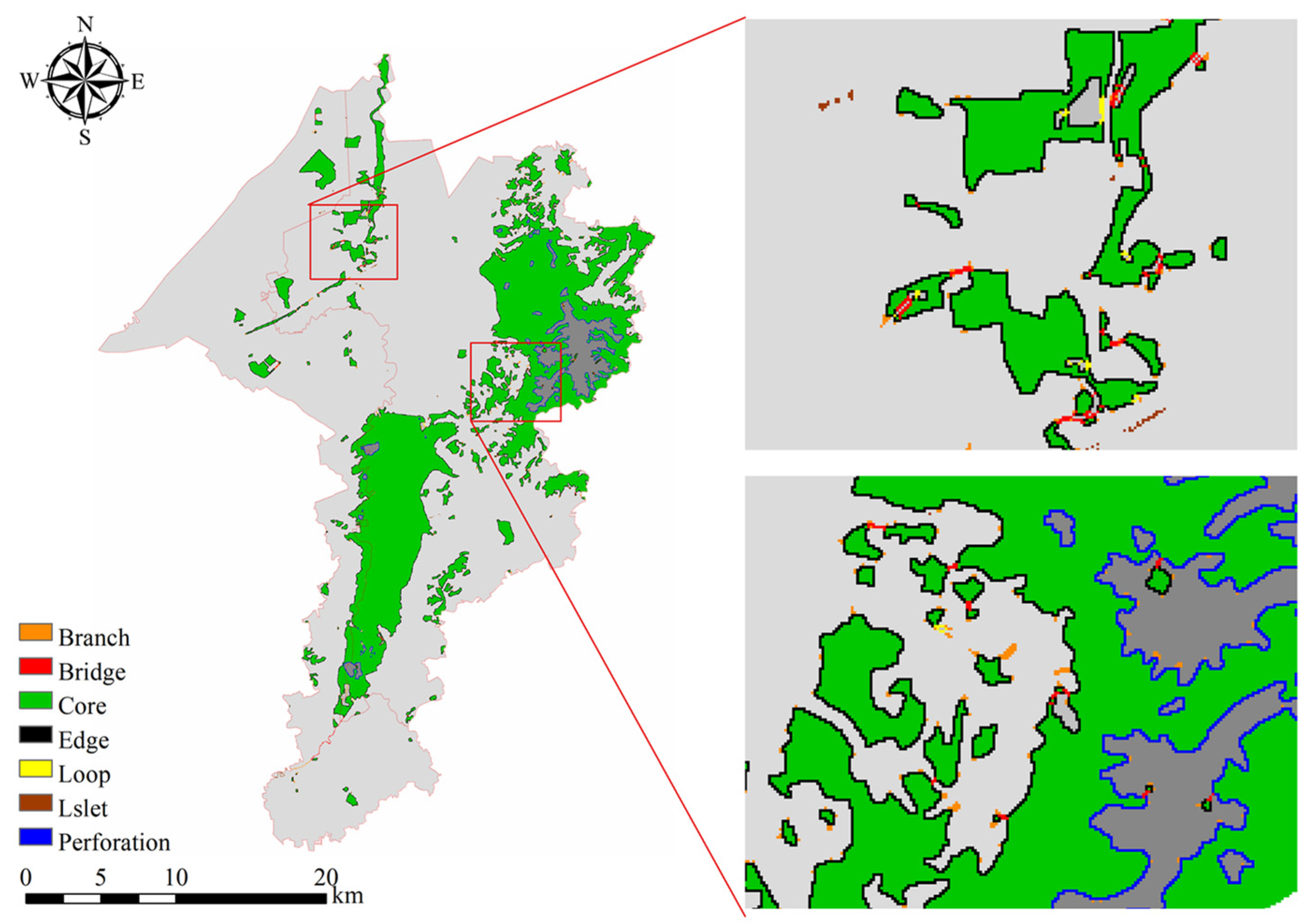
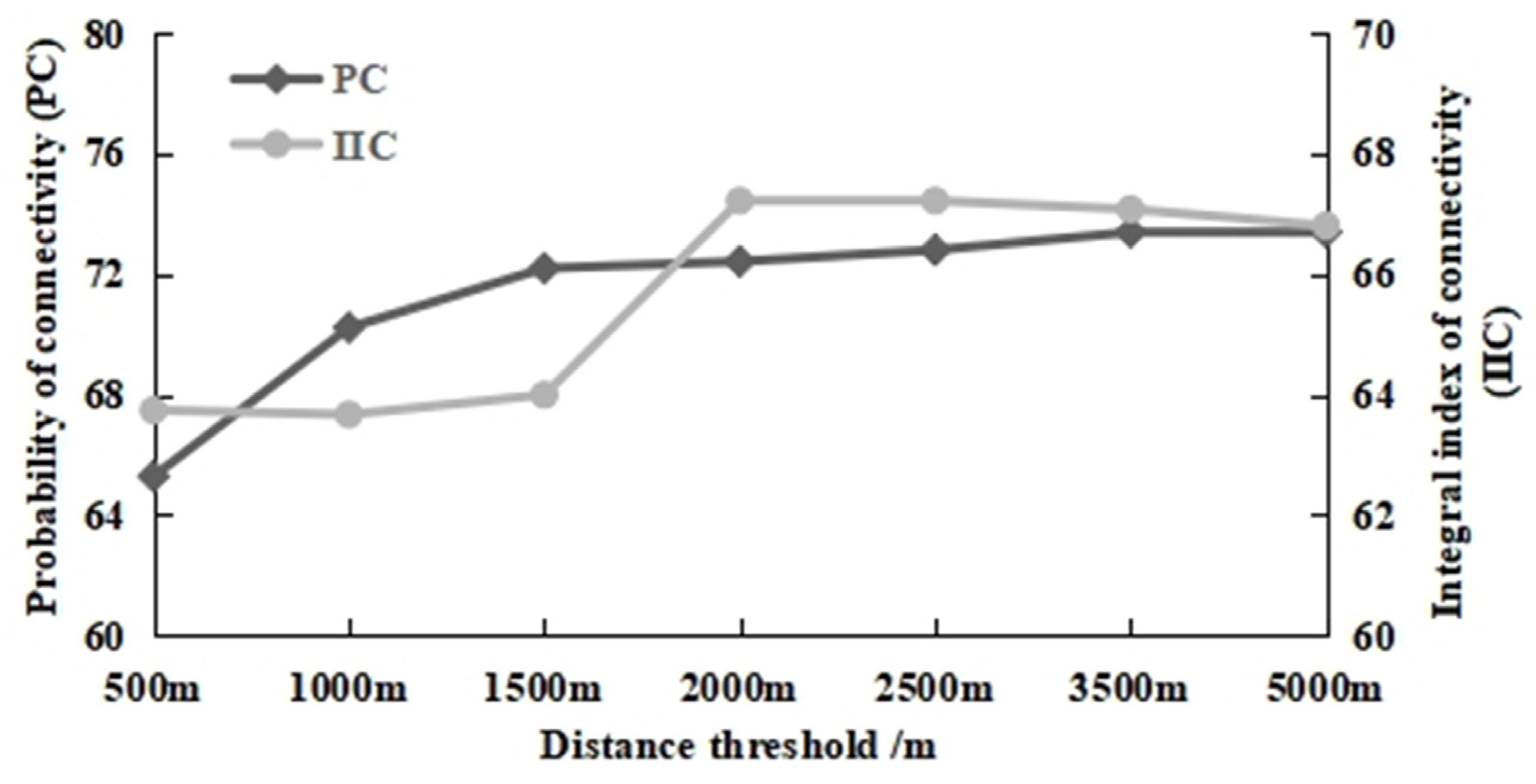
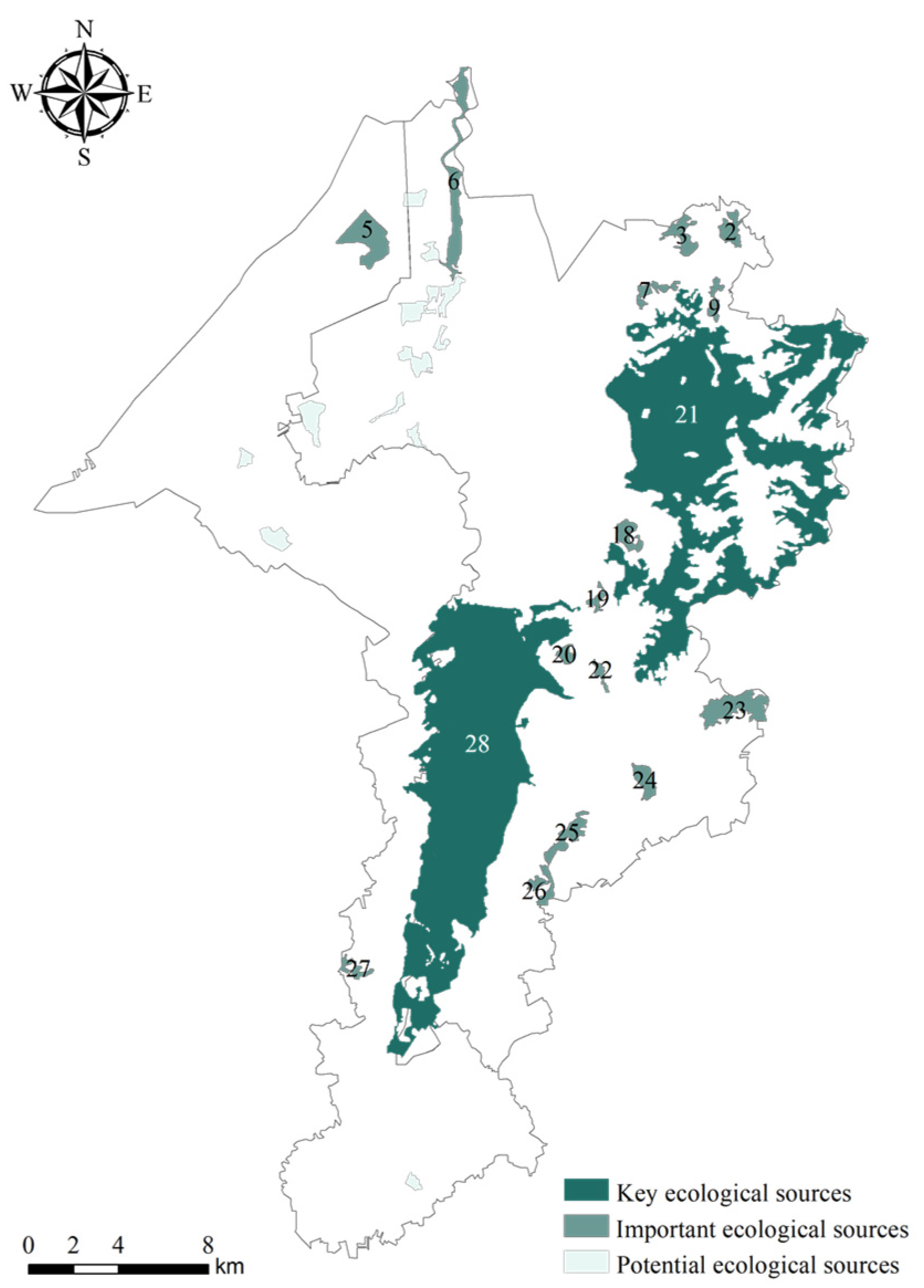
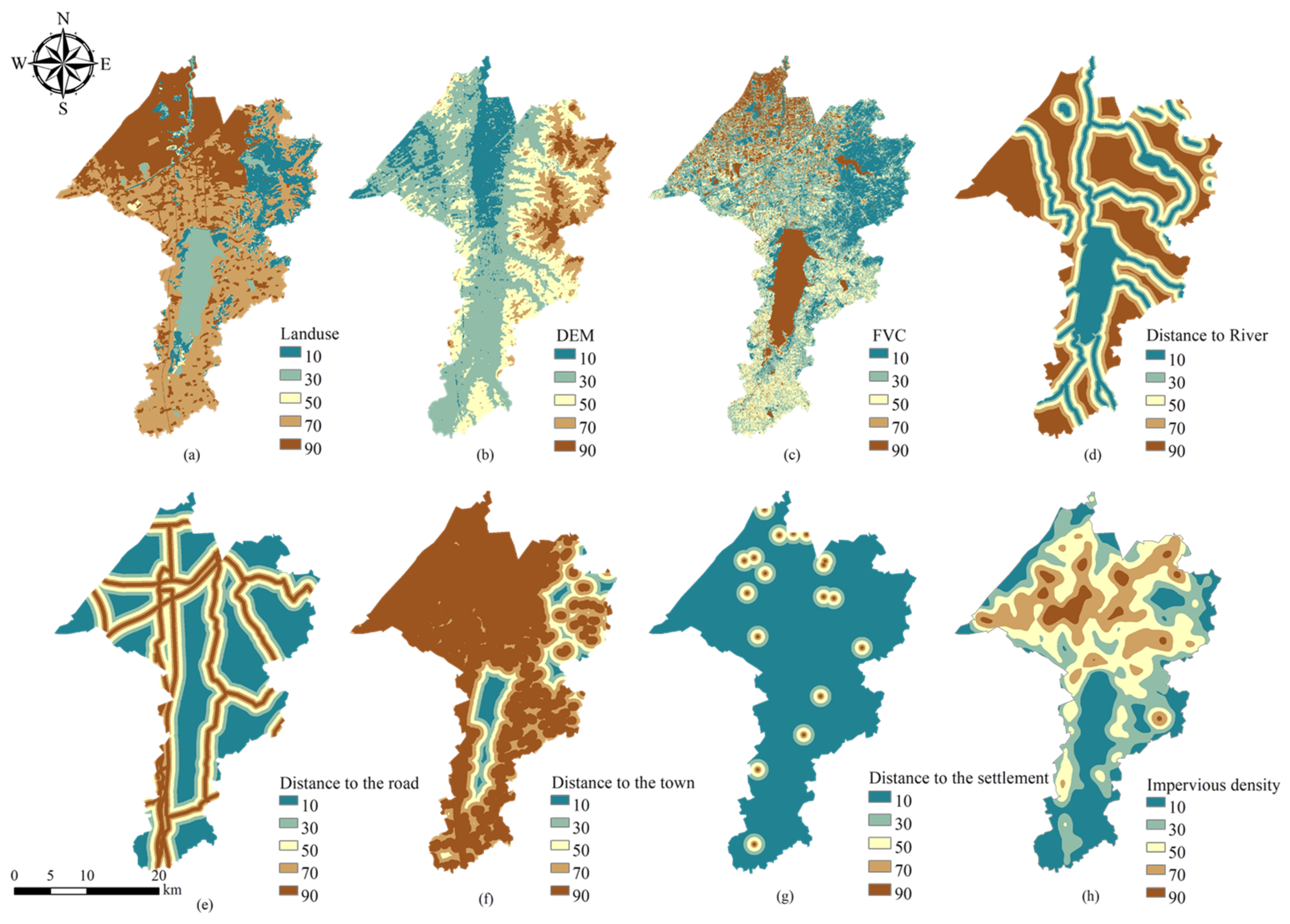
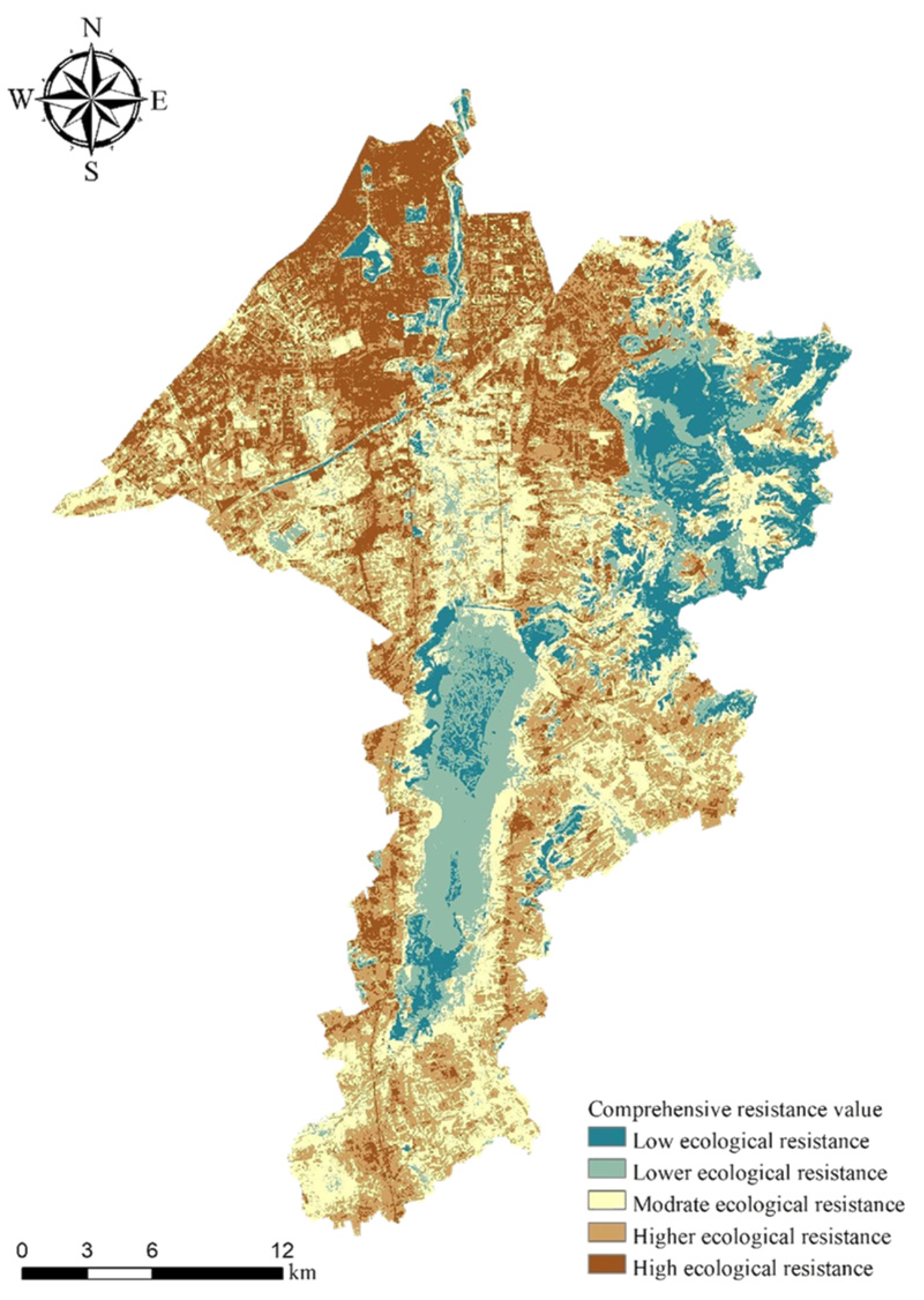
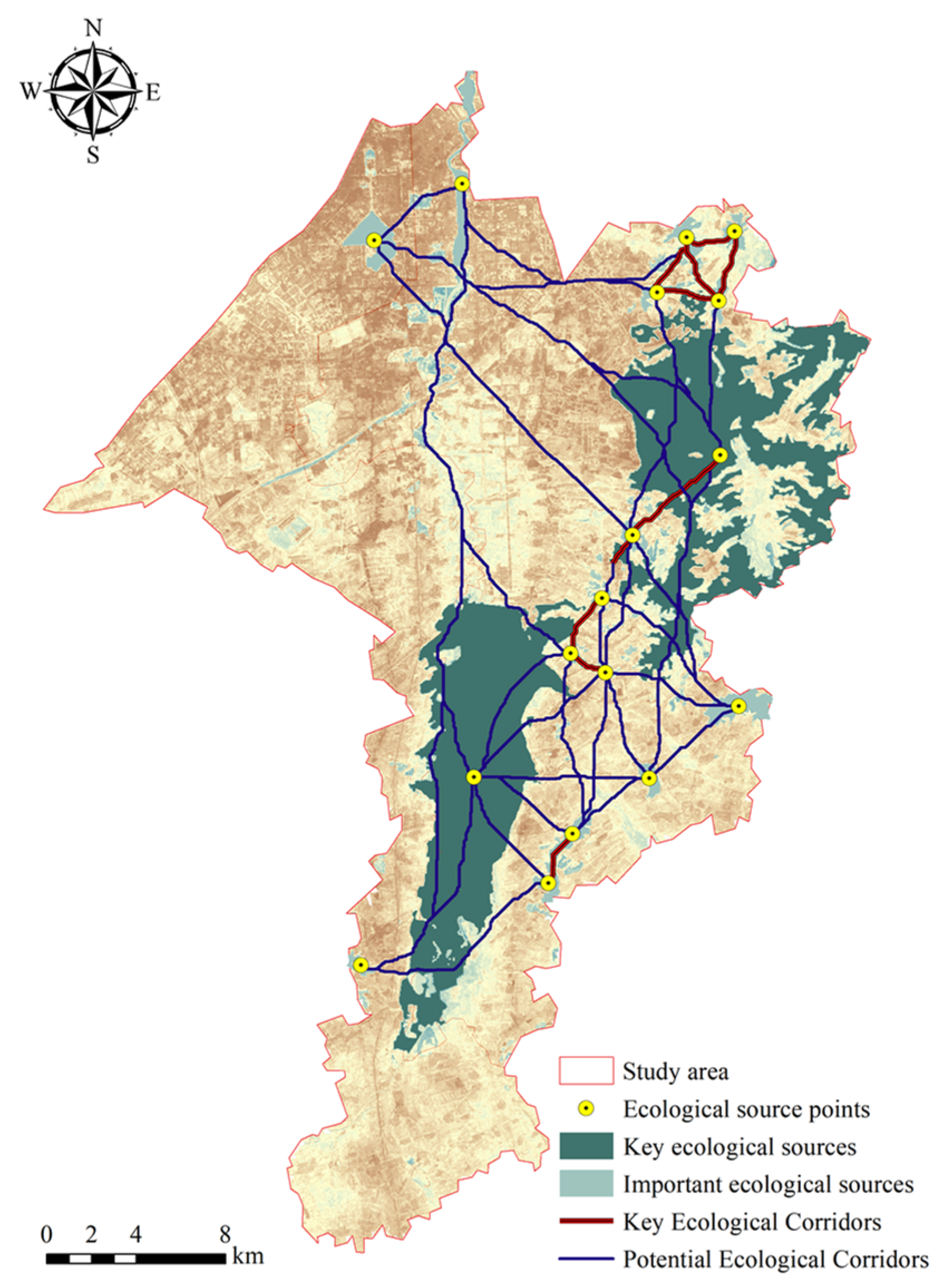
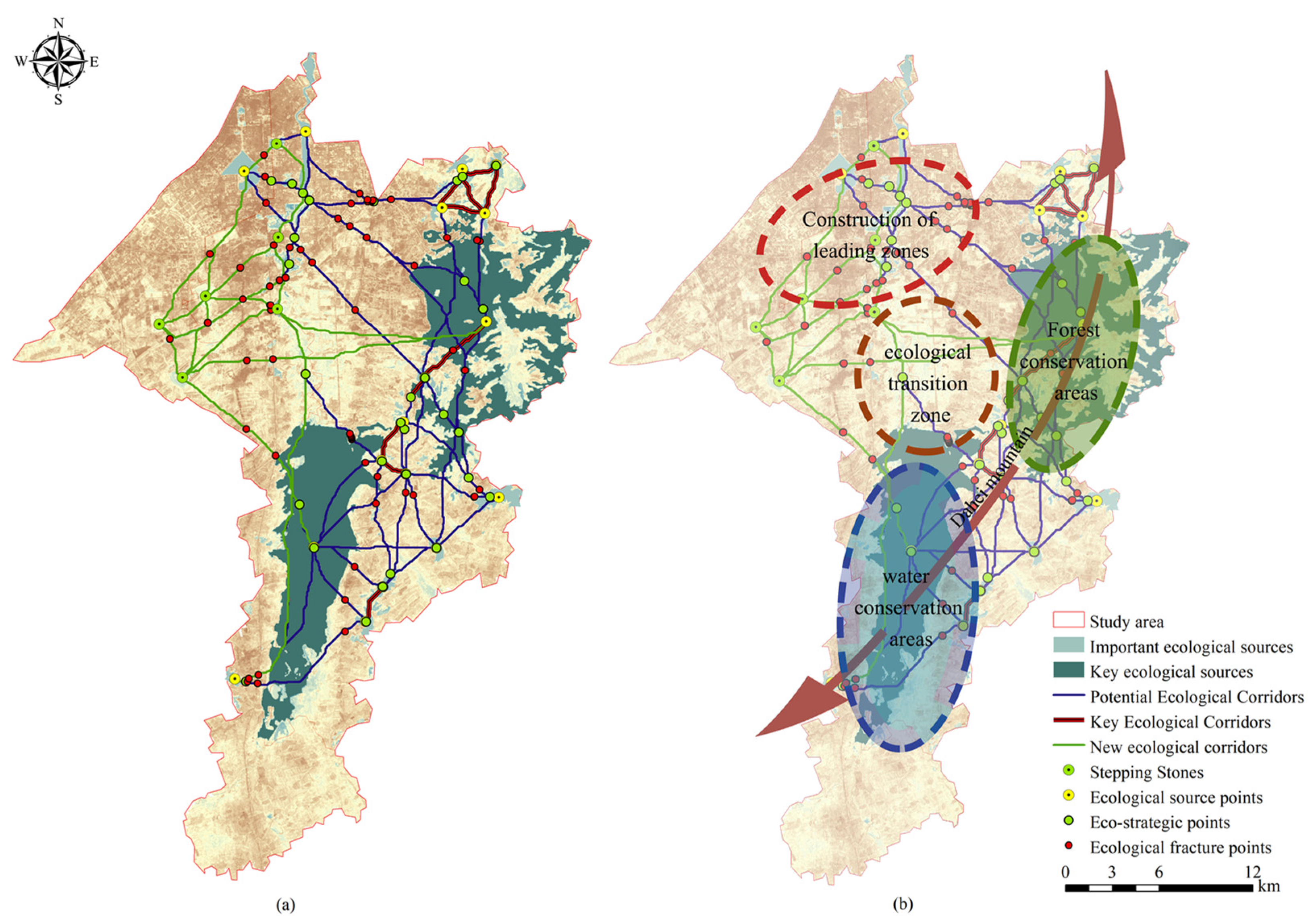
| Resistance Factors | Resistance Coefficient | Weights | |||||
|---|---|---|---|---|---|---|---|
| 10 | 30 | 50 | 70 | 90 | |||
| Natural causes | DEM/m | <200 | 200–225 | 225–250 | 250–285 | >300 | 0.104 |
| Land use | Woodland | Waters, wetland | Grassland | Cultivated land | Construction land | 0.289 | |
| Vegetation cover | >0.8 | 0.8–0.6 | 0.6–0.4 | 0.4–0.2 | <0.2 | 0.168 | |
| Distance to River/m | <100 | 100–500 | 500–1000 | 1000–1500 | >1500 | 0.031 | |
| Human factor | Distance to the road/m | >2000 | 2000–1500 | 1500–1000 | 500–1000 | <500 | 0.083 |
| Distance to the settlements/m | >4000 | 2000–4000 | 1000–2000 | 500–1000 | <500 | 0.052 | |
| Distance to the town/m | >2000 | 1000–2000 | 500–1000 | 200–500 | <200 | 0.198 | |
| Impervious density | <3 | 3–6 | 6–10 | 10–15 | >15 | 0.075 | |
| Landscape Type | Area/km² | Prospect Area Proportion/% | Proportion of Study Area |
|---|---|---|---|
| Core | 173.97 | 86.26% | 21.30% |
| Islet | 0.20 | 0.10% | 0.02% |
| Perforation | 3.91 | 1.94% | 0.48% |
| Edge | 20.87 | 10.35% | 2.56% |
| Bridge | 0.63 | 0.31% | 0.08% |
| Loop | 0.25 | 0.13% | 0.03% |
| Branch | 1.84 | 0.91% | 0.23% |
| total | 201.67 | 100% | 24.7% |
| Distance Gradient | 500 m | 1000 m | 1500 m | 2000 m | 2500 m | 3500 m | 5000 m |
|---|---|---|---|---|---|---|---|
| dPC | 65.278 | 70.214 | 72.182 | 72.408 | 72.785 | 73.378 | 73.381 |
| IIC | 63.737 | 63.665 | 63.991 | 67.211 | 67.211 | 67.071 | 66.799 |
| Sort | Source Number | dIIC | dPC | Plaque Area/km2 | Proportion of the Core Area Landscape/% |
|---|---|---|---|---|---|
| 1 | 21 | 67.212 | 72.7858 | 71.26 | 40.96% |
| 2 | 28 | 65.2079 | 69.6301 | 69.37 | 39.87% |
| 3 | 19 | 0.3229 | 12.0095 | 0.35 | 0.20% |
| 4 | 23 | 0.0466 | 1.8169 | 2.72 | 1.56% |
| 5 | 25 | 0.9842 | 1.263 | 1.28 | 0.74% |
| 6 | 18 | 0.6862 | 1.1196 | 0.89 | 0.51% |
| 7 | 3 | 0.9144 | 1.0447 | 1.17 | 0.67% |
| 8 | 7 | 0.5379 | 0.9809 | 0.69 | 0.40% |
| 9 | 9 | 0.4320 | 0.7888 | 0.55 | 0.32% |
| 10 | 2 | 0.5274 | 0.7075 | 0.96 | 0.55% |
| 11 | 26 | 0.6408 | 0.6948 | 0.83 | 0.48% |
| 12 | 20 | 0.3102 | 0.4893 | 0.40 | 0.23% |
| 13 | 27 | 0.3888 | 0.4586 | 0.51 | 0.29% |
| 14 | 24 | 0.0057 | 0.3158 | 0.95 | 0.55% |
| 15 | 22 | 0.2787 | 0.2963 | 0.30 | 0.17% |
| 16 | 6 | 0.1826 | 0.2648 | 3.20 | 1.84% |
| 17 | 5 | 0.1523 | 0.1709 | 2.79 | 1.60% |
| Total | 165.74 | 95.27% |
| 2 | 3 | 5 | 6 | 7 | 9 | 18 | 19 | 20 | 21 | 22 | 23 | 24 | 25 | 26 | 27 | 28 | |
|---|---|---|---|---|---|---|---|---|---|---|---|---|---|---|---|---|---|
| 2 | 43.86 | 0.47 | 0.58 | 9.16 | 17.71 | 1.21 | 0.65 | 0.52 | 3.47 | 0.48 | 0.50 | 0.26 | 0.29 | 0.22 | 0.13 | 0.38 | |
| 3 | 0.66 | 0.83 | 29.89 | 21.38 | 1.59 | 0.84 | 0.65 | 4.69 | 0.60 | 0.63 | 0.32 | 0.35 | 0.27 | 0.15 | 0.47 | ||
| 5 | 6.47 | 0.69 | 0.54 | 0.45 | 0.34 | 0.36 | 0.68 | 0.28 | 0.24 | 0.14 | 0.23 | 0.19 | 0.14 | 0.38 | |||
| 6 | 0.89 | 0.67 | 0.50 | 0.38 | 0.40 | 0.79 | 0.35 | 0.26 | 0.15 | 0.24 | 0.20 | 0.14 | 0.42 | ||||
| 7 | 22.71 | 1.79 | 0.88 | 0.65 | 5.34 | 0.59 | 0.61 | 0.30 | 0.33 | 0.25 | 0.14 | 0.45 | |||||
| 9 | 2.20 | 1.04 | 0.76 | 8.81 | 0.71 | 0.73 | 0.36 | 0.38 | 0.28 | 0.15 | 0.50 | ||||||
| 18 | 16.50 | 5.01 | 12.71 | 4.00 | 3.09 | 1.18 | 0.99 | 0.68 | 0.33 | 1.72 | |||||||
| 19 | 17.07 | 4.30 | 9.97 | 2.61 | 1.15 | 1.14 | 0.75 | 0.38 | 2.68 | ||||||||
| 20 | 2.53 | 44.88 | 2.62 | 1.96 | 2.14 | 1.28 | 0.54 | 5.20 | |||||||||
| 21 | 2.47 | 2.31 | 0.99 | 0.93 | 0.66 | 0.31 | 1.24 | ||||||||||
| 22 | 3.75 | 2.90 | 2.33 | 1.34 | 0.41 | 3.09 | |||||||||||
| 23 | 4.15 | 2.01 | 1.23 | 0.35 | 1.20 | ||||||||||||
| 24 | 6.81 | 2.84 | 0.43 | 2.07 | |||||||||||||
| 25 | 42.46 | 1.26 | 7.08 | ||||||||||||||
| 26 | 1.56 | 5.29 | |||||||||||||||
| 27 | 1.79 | ||||||||||||||||
| 28 |
Disclaimer/Publisher’s Note: The statements, opinions and data contained in all publications are solely those of the individual author(s) and contributor(s) and not of MDPI and/or the editor(s). MDPI and/or the editor(s) disclaim responsibility for any injury to people or property resulting from any ideas, methods, instructions or products referred to in the content. |
© 2023 by the authors. Licensee MDPI, Basel, Switzerland. This article is an open access article distributed under the terms and conditions of the Creative Commons Attribution (CC BY) license (https://creativecommons.org/licenses/by/4.0/).
Share and Cite
Zhou, X.; Hao, C.; Bao, Y.; Zhang, Q.; Wang, Q.; Wang, W.; Guo, H. Is the Urban Landscape Connected? Construction and Optimization of Urban Ecological Networks Based on Morphological Spatial Pattern Analysis. Sustainability 2023, 15, 14756. https://doi.org/10.3390/su152014756
Zhou X, Hao C, Bao Y, Zhang Q, Wang Q, Wang W, Guo H. Is the Urban Landscape Connected? Construction and Optimization of Urban Ecological Networks Based on Morphological Spatial Pattern Analysis. Sustainability. 2023; 15(20):14756. https://doi.org/10.3390/su152014756
Chicago/Turabian StyleZhou, Xudan, Chenyao Hao, Yu Bao, Qiushi Zhang, Qing Wang, Wei Wang, and Hongliang Guo. 2023. "Is the Urban Landscape Connected? Construction and Optimization of Urban Ecological Networks Based on Morphological Spatial Pattern Analysis" Sustainability 15, no. 20: 14756. https://doi.org/10.3390/su152014756
APA StyleZhou, X., Hao, C., Bao, Y., Zhang, Q., Wang, Q., Wang, W., & Guo, H. (2023). Is the Urban Landscape Connected? Construction and Optimization of Urban Ecological Networks Based on Morphological Spatial Pattern Analysis. Sustainability, 15(20), 14756. https://doi.org/10.3390/su152014756









